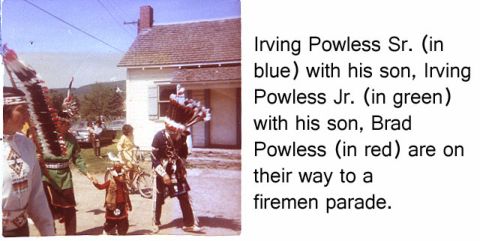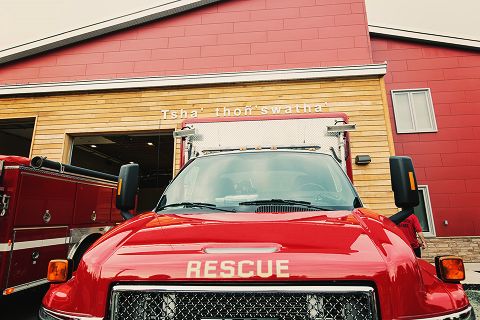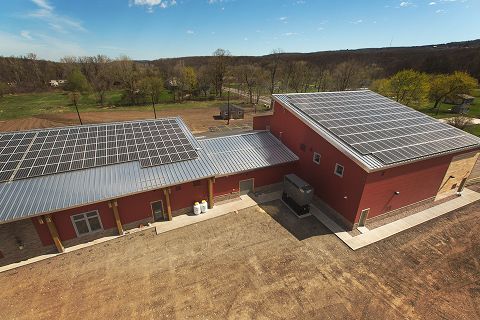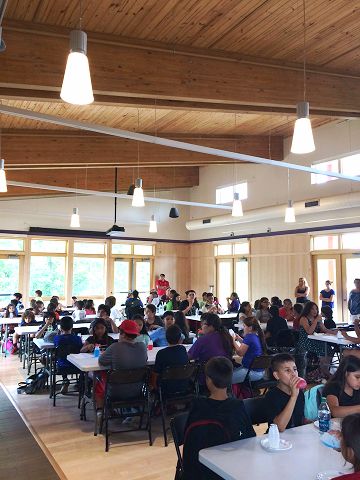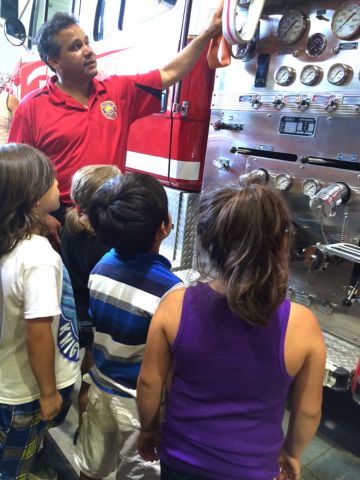 |
Canku Ota
|
 |
|
(Many Paths)
|
||
|
An Online Newsletter
Celebrating Native America
|
||
|
July 2015 - Volume 13
Number 7
|
||
|
|
||
|
TSHA' THONSWATHA':
The Journey To A New Firehouse |
||
|
by Onondaga Nation News
|
||
World War II just ended. The men have returned from overseas back to the Nation. From their experiences during the war, they expressed to our community the need for a fire department. "We started fundraising right away," said Sam Babcock, the Nation's first fire chief who is 85 years young. "We held 50/50 drawings, turkey shoots, and raffles. It was a real community effort. Right away our Ladies Auxiliary began supporting us with first aid classes and even socials." As the nation began its effort to raise funds for the fire department, they decided that a festival could be created to help with the effort. They called the festival the Green Corn Dance. The festival would have crafters, food and would share cultural dances. To promote the event, the fire department would attend parades in the surrounding communities. "It seemed as though we were always in a parade," recalled Chief Irving Powless Jr, who was the Nation's third fire chief, following in the steps of his father who was the second fire chief. "My father didn't know how to march. No matter how hard we tried to teach him, he couldn't. But the people loved to see him and the rest of us in our outfits come marching down the streets." Soon other local fire departments heard of the Nation's desire to have a fire department. One department decided to donate one of their trucks to the Onondaga Nation.
"With that donation, we became the first all-native volunteer fire department in the United States. We are very proud of that accomplishment," added Chief Powless. "This was an especially proud moment as the Nation doesn't accept any outside funding from the State of New York or the United States." As the Nation department grew, so did the need for a firehouse. In the early 1970's, the Onondaga's were able to acquire steel beams and siding for their new firehouse. The Nation had plenty of volunteer journeymen craftsmen of all trades to aid in its construction. There is a long tradition of native ironworkers and connectors who have built skyscrapers. Connectors like Richard Johnson, Horace Cook, Andy Cook, and many more were eager to help. Chief Vince Johnson was also a connector at the time and volunteered to help with the construction. "We were all set to tie off our first steel girders," said Chief Johnson. "But the anchor bolts of the steel column that I was standing on pulled free! All of the men grabbed the column to prevent it from falling over. They all saved me. After that, the construction went off without a hitch." The completed firehouse then became more than a place for our fire trucks. Pancake breakfasts, birthday parties, graduation parties, banquets, and a lacrosse locker room were just a few of the types of events that were being hosted there. But with the constant use, the building soon began to show wear and tear. The insulation wasn't holding in the heat and in the winter, mainly due to the holes that grew from the corroded steel siding. Current Fire Chief Ron Shenandoah recollects about the time he and the late Council Faithkeeper Ed "Cookie" Cook approached the Council about the state of firehouse. "It was almost ten years ago that Cookie and I approached the Council about replacing the fire barn. We had a construction company who could build a similar steel structure for us. The Council agreed that it was something that needed to be done, but the Nation was too busy at that time in building a factory. We were told to wait." After years passed, the Onondaga Nation School was scheduled for a structural review. When architects from Ashley McGraw began touring the school, they met Onondaga council member Brad Powless. Brad Powless explains, "In listening to the principles that our elder leaders spoke of in Council, there was a connection to what Ashley McGraw was trying to do in their structures. We began a dialogue about what Nation wanted to accomplish on Onondaga Lake as well as structures on the Nation. We began listening and learning from each other. It was a great start." Ashley McGraw designs firehouses, schools, and other large community buildings. They began designing buildings with the principle of working with nature, not against it. One of their successes is Syracuse University's Center of Excellence. Founder of Ashley McGraw Architects, Ed McGraw recalls elements of the Center of Excellence project. "It was a great challenge. Not so much in the construction, but in the changing of the mindset of the building itself. The use of natural light, rainwater harvesting, geothermal heating, and recognizing how the people will function within the building and accommodating their uses first instead of the people becoming accustomed to the building was a new mindset." Ed continues, "Council member Brad Powless then invited us to the longhouse to present our ideals in how we could design a firehouse for the Nation. We were very excited, as a Syracuse-based company, to be presenting in the Longhouse. Obviously we knew about the Onondaga Nation and their wishes for a clean lake and healthy environment. Now we were in the Longhouse presenting our ideas on how that could be achieved. It was memorable experience to say the least." Their presentation made an effect on the entire Council. "After listening to their presentation, it became clear that we couldn't build a similar steel structure to the building we currently had," stated Tadodaho Sid Hill. "We couldn't build a firehouse that would repeat the same problems we have now. We then began to work with Ashley McGraw to come up with a better firehouse." "I've been in a lot of different firehouses," stated Ron Shenandoah. "I have a good idea of what works and what wouldn't. Plus our Nation firehouse is unique. It should represent who we are." The new firehouse is named Tsha' Thoñswatha,' meaning "Where they put it out." The aspirations of the Tsha'
Thoñswatha were: It will be built by the people, a work of the Nation; It will walk gently on Mother Earth; It will be a vital part of the community and draw the community closer; It will be a showpiece and destination for others to see and use; and People will learn from the building and the experience of building it. "I've had great meetings with the leaders and people from the Nation," said lead architect Andrew Schuster. "We've really tried to apply what the Nation said they wanted and designed it into the building. The idea of 'gently walking on the earth' really led us in making decisions on design, materials, and longevity." Ashley McGraw established a materials ethic that created a clear set of values to quickly judge decisions made both during design as well as changes during construction. The goal was to align the goals of the Nation and the designers with a different approach to thinking and acting. The basic criteria for materials: is it natural, is it local,
is it recyclable/renewable, and does it use oil? One of the first
things that people notice about the Tsha' Thoñswatha' is
that it is made out of wood, not steel.
"The rationale of wood over steel is that you can cut a tree, then replant a new one. The wood is nearby so there is not a huge effect of transportation," explained Andrew Schuster. "With steel, the material is dug out of the earth (which leaves a huge hole), melted down, forged into pieces and shipped. That entire process uses a lot of energy and releases more carbon into the air while the cut lumber actually traps in the carbon." "We really wanted to incorporate the walking gently on Mother Earth in designing the heating and cooling systems," added Ed McGraw. "This firehouse is equipped with an array of solar panels that can provide 100KW of power, ten wells were dug 400 feet to provide geothermal heating and cooling, radiant flooring in the truck bays, and the use of natural light to reduce the need to turn on the LED lighting. There is not a building like this for 400 miles. The building is designed to produce as much renewable energy as it uses during an annual basis. Our computer models show a net-zero energy building." Tsha' Thoñswatha' has some major improvements over the old firehouse. The firehouse is now set back far enough so that the trucks can now idle on a parking lot without stopping traffic. Tsha' Thoñswatha' now has room for more as well as bigger trucks. The trucks with the new drainage system can be washed inside during the winter. There is space for their gear and a large storage space. Tsha' Thoñswatha' also provides a decontamination room for fire responders coming back from a call where they may have been exposed to harmful elements. Tsha' Thoñswatha' also provided a much needed office and a meeting room for their classes.
Like its predecessor, Tsha' Thoñswatha' will not just serve as a firehouse. A beautiful wood community hall was added for the community members to utilize. Tsha' Thoñswatha' is equipped with a state of the art kitchen, a sheltered gathering area outside, and room for approximately 150 seated people. "The wood in the community hall is striking," said Andrew Schuster. "The use of wood was important in the community area. It is reminiscent of a longhouse on the inside and gives the impression of a forest on the outside of the building. I hope the people are really going to gravitate to this building." Tsha'thoñswatha' is a state of the art building, built to help serve the needs of the community. Just like the people who started the fire department in the 1940s and 50s. "We hope more young men and women want to come out and help our community," said Sandy Burk, Assistant Fire Chief. "The work here is so gratifying." Working to help the people has made the Onondaga Nation reach out to different service agencies to help. People like Chief Alie Gibson initiated and have maintained connections to provide safety to the people of the Nation. Ron Shenandoah explains, "We work with many different agencies, like Smitty in Nedrow Volunteer Fire Department and the people at ambulance service, TLC. It is great to have this partnership with them. I feel proud that these people are there to help us to give the best care to the people of the Nation. You don't get a lot of thank you's in the job we do. But we want to work for our community. We want to give back." So on Monday, June 15, 2015, the Nation's ONVFD gave tours of the facility to the residents of the Nation. School children were let out school early and the entire community was invited to share in the excitement of the new building. "It really is an amazing building," said Brad Powless. "From the early steps from concept drawings, meetings and now actually being able to be in here, truly a great feeling seeing all of the smiling faces as they walk through. What a great day." Tadodaho Sid Hill added, "We have a building that is designed to work with Nature and to be energy self-sufficient. I think that a lot of people are going to want to see what we've accomplished." |
|||||||
|
|
||
|
|
||
| Canku Ota is a free Newsletter celebrating Native America, its traditions and accomplishments . We do not provide subscriber or visitor names to anyone. Some articles presented in Canku Ota may contain copyright material. We have received appropriate permissions for republishing any articles. Material appearing here is distributed without profit or monetary gain to those who have expressed an interest. This is in accordance with Title 17 U.S.C. Section 107. | ||
|
Canku Ota is a copyright ©
2000 - 2015 of Vicki Williams Barry and Paul Barry.
|
||
 |
 |
|
|
The "Canku
Ota - A Newsletter Celebrating Native America" web site and
its design is the
|
||
|
Copyright ©
1999 - 2015 of Paul C. Barry.
|
||
|
All Rights Reserved.
|
||

